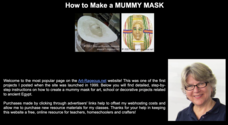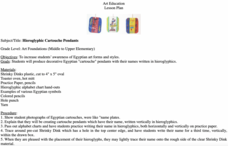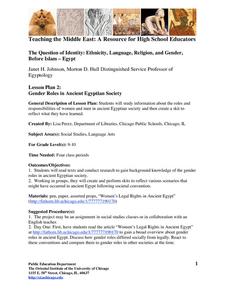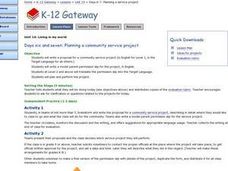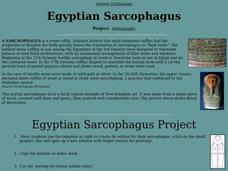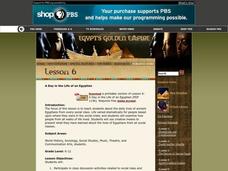Curated OER
Egyptian Relic: Ceramics Lesson
Egyptian artwork is inspiring in so many ways. Learners discover the world of Egyptian relics as they make a ceramic version of their own. Multiple resource links and full instructions make this a fun and easy-to-incorporate art project...
Mary Pope Osborne, Classroom Adventures Program
Mummies in the Morning Egyptian pyramids, hieroglyphics
Visit the Magic Treehouse and take your class on a trip through time with a reading of the children's book Mummies in the Morning. Using the story to spark an investigation into Egyptian culture, this literature unit engages...
New York City Department of Education
Egypt
This six-week unit encompasses all subjects with a focus study on world history and the development of ancient civilizations. As gifted and talented students dive into the interesting yet challenging topic of Egypt, they...
Curated OER
Egyptian Masks
Ninth graders investigate the different types of Egyptian art including relief sculpture, sculpture in the round, and Egyptian architecture. They view and discuss pictures of Egyptian sarcophagi and compare them with current day coffins...
Curated OER
Egyptian Fairy Tale
Learners explore ancient Egyptian culture and government. In this social studies lesson plan, students compare the legal system from ancient Egypt to our current American legal system. Links are included for web searching Egypt and the...
Curated OER
How to Make a Mummy Mask
With some plaster casting materials and a quick lesson on the ancient burial traditions of Egypt, your class can create amazing mummy masks. Listed here are all the tools, precautions, and steps needed for each child to make an Egyptian...
Curated OER
King Tut On The Move
Students read a story called King Tut On the Move and answer vocabulary and comprehension questions about it. In this current events King Tut lesson plan, students respond to literature by answering questions, recalling details, sharing...
Curated OER
Hieroglyphic Cartouche Pendants
In ancient Egypt, mummified bodies were embellished with elaborate cartouches housing the name of the deceased. Elementary artists can read all about Egyptian burial practices then create a cartouche of their own using clay and real...
Curated OER
Egyptian Diary Project
Seventh graders complete a journal activity in conjunction with a study of ancient Egypt. In this history and writing lesson, 7th graders write a journal entry based on the life of an ancient Egyptian pharoah they create.
Curated OER
Lesson: Nimble Symbols
Comparative thinking is one way to build critical analysts. Budding artists discuss symbols and how they represent concepts, beliefs, or ideas. They compare the symbols found on an ancient Egyptian mummy case to those found in...
University of Chicago
Gender Roles in Ancient Egyptian Society
After reading about the legal status of women in the Old Kingdom of ancient Egypt and doing some additional research, your young historians will work in groups to develop short skits that reflect a typical gender-role related scenario...
Describing Egypt
Horemheb - (18th Dynasty)
Who was Horemheb and why is his tomb so famous? An fascinating resource uses virtual reality tools and even comes equipped with the ability to use a VR headset. Learners view information panels to the side of the location to understand...
Curated OER
Draw Like an Egyptian
Students discover the cultural history of Egypt by illustrating Egyptian figures. In this art history lesson, students analyze the Egyptian styles of figure drawings and emulate that by creating their own illustrations using an...
Curated OER
The Zabbaleen, Cairo's Garbage Workers
Here is a fascinating human geography study of the Zabbaleen. They are a sub-class of people who work as garbage collectors in Cairo, Egypt. I can't say enough good things about this resource in my limited space here. It is fabulous! If...
Curated OER
Planning a Community Service Project
Students practice using a new language to plan a community event. In this civics lesson, students practice writing a proposal for a community project using their target language. Students brainstorm in small groups what their...
Curated OER
Cinderella Trilogy
Young scholars look at three different versions of the Cinderella story. In this comparative literature lesson, students read the Chinese version "Yeh-Shen", the Egyptian version "Rhodopis," and the Native American version "The Hidden...
Curated OER
A Day in the Life
Students inquire about the politics and culture of Ancient Rome. In this Ancient Rome project/unit, students research life during ancient Roman times and create a newspaper with articles on politics, sports, culture, and economics.
Curated OER
Sarcophagus
Here is another in a series of fantastic art lessons from this source. This one has young artists create a sarcophagus-style clay box! This lesson would be ideal to utilzie during a study of the ancient Egyptians. One note of caution:...
Curated OER
Understanding Civilizations through Art
Students research artwork, and create their own using their research as a model. They write a report on the importance of artwork in civilizations.
Curated OER
Now You're Speaking My Language; Deciphering the Symbols of Early Civilizations
Young scholars explore early attempts at written language. In this early civilizations lesson, students investigate first attempts at written communication. Among the civilizations covered are Mayan, Greek, and Egyptian.
Curated OER
Communicating with My World
Students create a time capsule. In this oral presentation and history preservation lesson, students provide feedback for their time capsule project, work with a partner to write an oral presentation, and present their time capsule to the...
Curated OER
A Day in the Life of an Egyptian
Students study the daily lives of ancient Egyptians from every social class. They use creative means to present what they have learned about the lives of Egyptians from all social classes.
Curated OER
The Uluburun Shipwreck Project: Interconnections through Trade in the Late Bronze Age Mediterranean World
Ninth graders examine causes and effects of the Uluburun shipwreck. In groups, they develop their own ways to categorize the artifacts found on the ship and decide on the research questions they are going to focus on. They use the...





